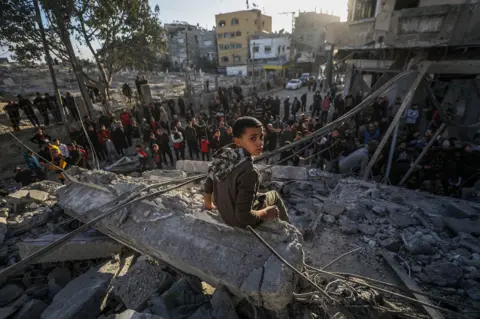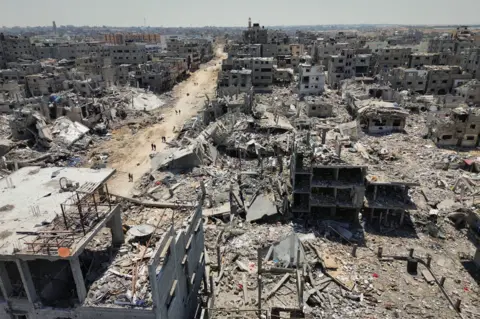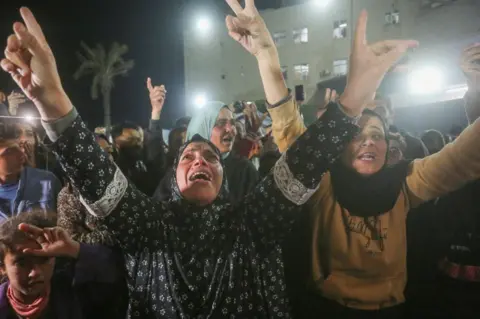Gaza is waiting for a ceasefire, fearing a last-minute catastrophe.
 EPA
EPAAs Israel’s cabinet met in Jerusalem to finalize a temporary ceasefire with Hamas, civilians in Gaza looked forward to a respite on Friday after 15 months of relentless war.
The Hamas-run Civil Defense Agency in Gaza said that as they waited, Israeli airstrikes killed at least 113 people after the agreement in principle was reached on Wednesday night.
The agreement, which was concluded on Friday afternoon, will take effect on Sunday and will leave a little more than 24 hours for the people of Gaza.
“Time is slower than ever,” said Dr. Abdullah Shabir, 27, an emergency physician at Baptist Hospital in Gaza City. “You can lose your life at any moment,” he said. “Sitting at home, walking on the street – no warning.”
Dr. Shabir was on shift at the hospital on Wednesday night when news of the ceasefire reached him. It was a brief moment of euphoria, but less than an hour after the announcement, a wave of airstrikes separated the delegation from the flood of dead and wounded.
Every member of staff was called. “It was as bad as we saw it,” Dr. Shabbir said. “Severe injuries, serious burns, of course many died.”
 EPA
EPAAmong the dead on Thursday was his colleague Hala Abu Ahmed, a 27-year-old internal medicine specialist who two colleagues of the Baptist described as a faithful and promising young doctor and a kind man.
She had worked tirelessly and under great pressure for 15 months since the start of the war, said Dr. Ahmed Eliwah, head of the emergency department, and was killed after a ceasefire agreement was reached.
Many of the millions displaced by the war were waiting to return home for the first time since the war began. Many find a bombed-out desert instead of their home.
“My house is completely destroyed, the building is gone,” said Sabine Doshan, 45, who owns a street kiosk and lives in a residential unit in Gaza City.
Doshan said she has lost 17 members of her extended family since the war began. She was preparing to leave for the ruins of her home in Deir al-Balah in central Gaza, where she lived in a tent.
“Even if I throw my tent on the rubble, it will be alright, because I will be home,” she said. “Now I’m not satisfied anywhere but my home.”
The devastation of the Gaza Strip is immense. According to a recent analysis by the United Nations Satellite Centre, 69% of all structures and 68% of roads have been destroyed or damaged since December. According to the Hamas-run Ministry of Health, some 46,700 people have been killed.
In October 2023, Israel planned to eliminate Hamas in Gaza after the group attacked southern Israel, killing nearly 1,200 people and taking 251 hostages.
For Gazans, the joy of a long-awaited ceasefire has been tempered by the level of death and destruction. “By God, it’s mixed feelings,” said Wael Mohammed, a freelance journalist living in a refugee camp in central Gaza.
“From one moment to another, from joy to pain,” he said. “I’m glad the bloodshed has stopped, but we’re living in misery.”
 Getty Images
Getty ImagesAs of Friday afternoon, the cease-fire agreement was finally working its way through Israel’s political system for approval. A first group of three hostages will be released early Sunday in exchange for some 95 Palestinian prisoners.
But in the next six weeks, the exchange is fraught with the possibility of failure.
“The biggest challenge is whether the ceasefire agreement will be successfully implemented,” said Ms. Juliette Touma, director of communications for the United Nations refugee agency UNRWA.
“If so, the challenge ahead is still huge. Many of the shelters are overcrowded. Many are simply living in the fields or in makeshift buildings. They don’t have basic needs like warm clothes. I wouldn’t call these living conditions. They are not humane conditions.
In Gaza Friday, some were focused on Sunday, and whether they would take a break there before the deal collapses.
“We are afraid of any change or movement,” said Khalil Natel, 30, from Jabalia, north of the Gaza Strip, at the beginning of the war.
“The news is on,” Natel said from a shelter in central Gaza. We are watching and waiting.








